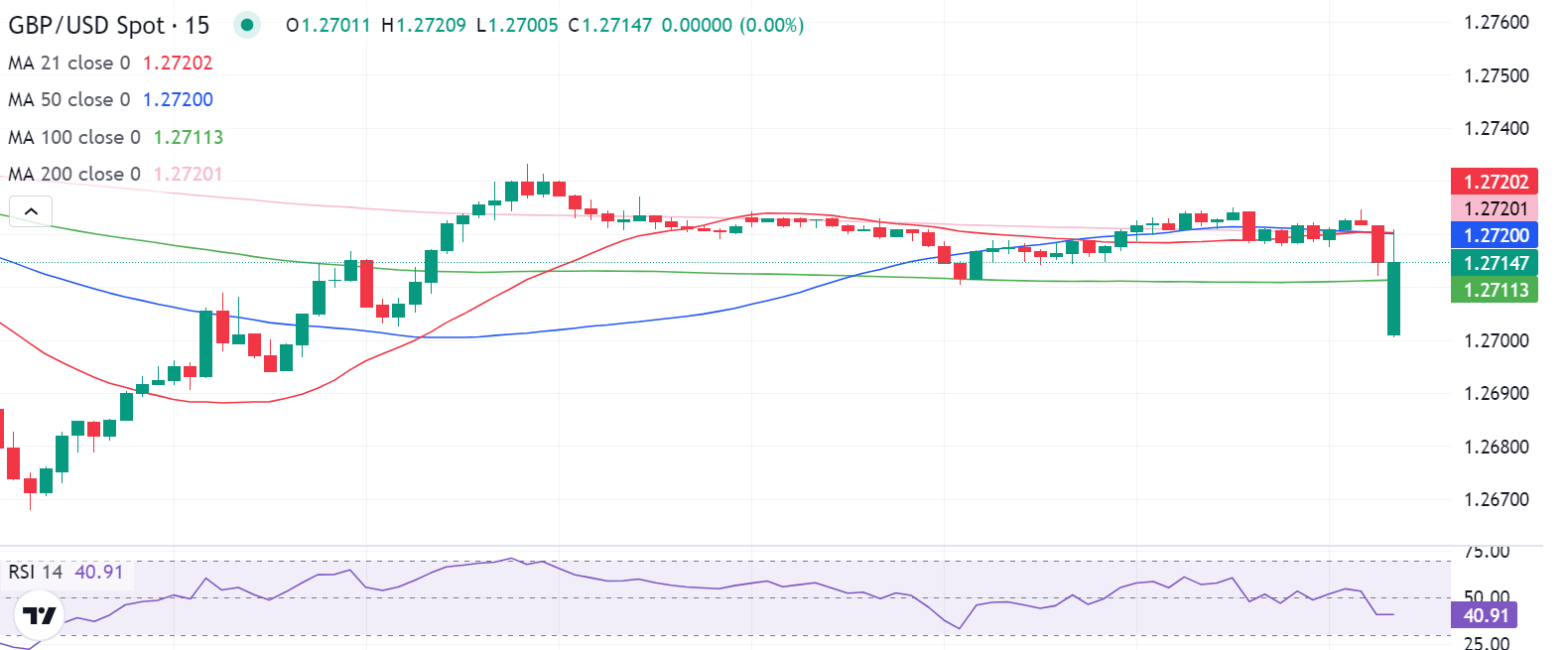- United Kingdom CPI rose 3.4% YoY in February vs. 3.6% forecast.
- Monthly British inflation jumped to 0.6% in February vs. 0.7% estimate.
- GBP/USD drops to test 1.2700 on UK CPI inflation data.
Consumer Price Index (CPI) in the United Kingdom (UK) increased 3.4% over the year in February, cooling off from a 4.0% rise in January, the data released by the Office for National Statistics (ONS) showed Wednesday. The market consensus was for a 3.6% increase.
The Core CPI (excluding volatile food and energy items) rose 4.5% YoY in February, as against January’s growth of 5.1% while missing the expected 4.6% reading.
Meanwhile, the UK Consumer Price Index rebounded 0.6% MoM in February vs. expectations of a 0.7% jump and January’s 0.6% drop.
Additional details via ONS
UK Services CPI came in at 6.1% YoY in February.
Biggest downward contributions to annual CPI came from food, and restaurants and cafes.
Largest upward contributions came from housing and household services, and motor fuels.
Commenting on the February UK inflation report, Finance Minister Jeremy Hunt said, “inflation data sets the scene for better economic conditions which could allow further progress on our ambition to boost growth.”
GBP/USD reaction to the UK CPI inflation data
GBP/USD came under intense selling pressure and tested 1.2700 on the downbeat UK headline CPI data, before rebounding to near 1.2720, where it now wavers. The pair is trading modestly flat on the day.
GBP/USD:15-minutes chart
Pound Sterling price today
The table below shows the percentage change of Pound Sterling (GBP) against listed major currencies today. Pound Sterling was the weakest against the Australian Dollar.
| USD | EUR | GBP | CAD | AUD | JPY | NZD | CHF | |
| USD | -0.05% | 0.05% | 0.06% | -0.06% | 0.30% | 0.10% | 0.05% | |
| EUR | 0.05% | 0.10% | 0.12% | 0.00% | 0.36% | 0.15% | 0.11% | |
| GBP | -0.02% | -0.08% | 0.00% | -0.10% | 0.25% | 0.05% | 0.02% | |
| CAD | -0.06% | -0.11% | 0.01% | -0.11% | 0.24% | 0.04% | 0.00% | |
| AUD | 0.05% | 0.00% | 0.11% | 0.11% | 0.36% | 0.16% | 0.11% | |
| JPY | -0.30% | -0.34% | -0.25% | -0.25% | -0.35% | -0.20% | -0.24% | |
| NZD | -0.11% | -0.16% | -0.05% | -0.05% | -0.16% | 0.20% | -0.05% | |
| CHF | -0.06% | -0.10% | 0.01% | 0.00% | -0.10% | 0.25% | 0.05% |
The heat map shows percentage changes of major currencies against each other. The base currency is picked from the left column, while the quote currency is picked from the top row. For example, if you pick the Euro from the left column and move along the horizontal line to the Japanese Yen, the percentage change displayed in the box will represent EUR (base)/JPY (quote).
This section below was published at 23:15 GMT on Tuesday as a preview of the UK inflation data.
- The Office for National Statistics will publish the UK CPI data for February on Wednesday.
- United Kingdom’s headline and core annual inflation are likely to fall; monthly CPI is set to jump.
- The UK CPI report could significantly impact the BoE’s interest rate outlook and the Pound Sterling.
The United Kingdom’s (UK) Office for National Statistics (ONS) will publish the Consumer Price Index (CPI) data at 07:00 GMT on Wednesday, just a day before the Bank of England (BoE) monetary policy announcement.
Pound Sterling traders will eagerly look forward to the UK CPI inflation report for fresh cues on whether the BoE will signal its first interest rate cut or retain its “higher rate for longer” stance.
What to expect from the next UK inflation report?
The headline annual UK Consumer Price Index is seen rising 3.6% in February, slowing from a 4.0% increase registered in January. The reading would be at its lowest since September 2021 but still much above the BoE’s 2.0% target.
The Core CPI inflation is set to fall to 4.6% YoY in February after reporting a 5.1% growth in January. Meanwhile, the British monthly CPI is likely to rebound 0.7%, following January’s 0.6% drop.
Despite the UK economy tipping into a technical recession at the end of 2023, the BoE’s brighter economic outlook for this year has dissuaded it from leaning towards a dovish pivot.
At its February policy meeting, the BoE maintained the key rate at 5.25%. Governor Andrew Bailey remained non-committal on what will be the Bank’s next interest rate moves in the upcoming meetings. However, he said that "we need to keep policy sufficiently restrictive for sufficiently long, nothing more, nothing less,” depending on the incoming data.
The policy statement said that the “BoE sees upward risks to CPI from geopolitical factors including the Red Sea, while domestic price and wage risks now "more evenly balanced."
While testifying before the UK Treasury Select Committee (TSC) last month, Bailey explained that “we are looking beyond the temporary period when we expect CPI to return to target this year," adding that he is looking for more sustained progress on the reduction of more persistent elements of inflation.
Therefore, the details of the CPI report, including food prices and the sticky services inflation, will grab markets’ attention in the run-up to the BoE policy announcements.
Previewing the UK inflation data, analysts at TD Securities (TDS) noted that “inflation likely took a decent step down across the board in Feb, largely on the back of base effects. Restaurant prices are the main risk to this print due to uncertainty around the scope for a rebound after sales weighed on prices in Jan.”
“Services remain the key focus for the MPC, and here we look for the y/y rate to come down to 6.0% y/y (BoE: 6.1%),” the TDS analysts said.
When will the UK Consumer Price Index report be released and how could it affect GBP/USD?
The UK CPI data is due for release on Wednesday at 07:00 GMT. The Pound Sterling has been losing ground against the US Dollar in the lead-up to the United Kingdom’s inflation showdown. The US Dollar stays supported at one-week highs ahead of Wednesday’s US Federal Reserve (Fed) monetary policy decision.
A higher-than-expected headline and core inflation data could reverberate the BoE’s “higher rates for longer” view, providing a fresh lift to the Pound Sterling. In such a case, GBP/USD could stage an upswing toward the 1.2800 level. On the other hand, GBP/USD could resume its correction toward 1.2600 if the UK CPI data show a notable slowdown in inflationary pressures, as expectations of a second-quarter BoE rate cut could be back on the table.
Markets are pricing in the first BoE rate cut this year at the August 1 policy meeting.
Dhwani Mehta, Asian Session Lead Analyst at FXStreet, offers a brief technical outlook for the major and explains: “The GBP/USD pair is on a corrective decline from seven-month highs of 1.2893. The 14-day Relative Strength Index (RSI) has fallen below the midline, suggesting that the downside risks remain intact for the Pound Sterling.”
Dhwani adds: “A decisive break below the horizontal 50-day Simple Moving Average (SMA) at 1.2687 is needed to challenge the upward-pointing 100-day SMA of 1.2626. Further south, the 200-day SMA at 1.2595 could be retested. Alternatively, acceptance above the 1.2800 level on a daily closing basis is critical for GBP/USD to initiate a meaningful uptrend toward the multi-month high of 1.2893,” Dhwani adds.
Economic Indicator
United Kingdom Core Consumer Price Index (YoY)
The United Kingdom (UK) Core Consumer Price Index (CPI), released by the Office for National Statistics on a monthly basis, is a measure of consumer price inflation – the rate at which the prices of goods and services bought by households rise or fall – produced to international standards. The YoY reading compares prices in the reference month to a year earlier. Core CPI excludes the volatile components of food, energy, alcohol and tobacco. The Core CPI is a key indicator to measure inflation and changes in purchasing trends. Generally, a high reading is seen as bullish for the Pound Sterling (GBP), while a low reading is seen as bearish.
Read more.Why it matters to traders
The Bank of England is tasked with keeping inflation, as measured by the headline Consumer Price Index (CPI) at around 2%, giving the monthly release its importance. An increase in inflation implies a quicker and sooner increase of interest rates or the reduction of bond-buying by the BOE, which means squeezing the supply of pounds. Conversely, a drop in the pace of price rises indicates looser monetary policy. A higher-than-expected result tends to be GBP bullish.
BoE FAQs
The Bank of England (BoE) decides monetary policy for the United Kingdom. Its primary goal is to achieve ‘price stability’, or a steady inflation rate of 2%. Its tool for achieving this is via the adjustment of base lending rates. The BoE sets the rate at which it lends to commercial banks and banks lend to each other, determining the level of interest rates in the economy overall. This also impacts the value of the Pound Sterling (GBP).
When inflation is above the Bank of England’s target it responds by raising interest rates, making it more expensive for people and businesses to access credit. This is positive for the Pound Sterling because higher interest rates make the UK a more attractive place for global investors to park their money. When inflation falls below target, it is a sign economic growth is slowing, and the BoE will consider lowering interest rates to cheapen credit in the hope businesses will borrow to invest in growth-generating projects – a negative for the Pound Sterling.
In extreme situations, the Bank of England can enact a policy called Quantitative Easing (QE). QE is the process by which the BoE substantially increases the flow of credit in a stuck financial system. QE is a last resort policy when lowering interest rates will not achieve the necessary result. The process of QE involves the BoE printing money to buy assets – usually government or AAA-rated corporate bonds – from banks and other financial institutions. QE usually results in a weaker Pound Sterling.
Quantitative tightening (QT) is the reverse of QE, enacted when the economy is strengthening and inflation starts rising. Whilst in QE the Bank of England (BoE) purchases government and corporate bonds from financial institutions to encourage them to lend; in QT, the BoE stops buying more bonds, and stops reinvesting the principal maturing on the bonds it already holds. It is usually positive for the Pound Sterling.
Information on these pages contains forward-looking statements that involve risks and uncertainties. Markets and instruments profiled on this page are for informational purposes only and should not in any way come across as a recommendation to buy or sell in these assets. You should do your own thorough research before making any investment decisions. FXStreet does not in any way guarantee that this information is free from mistakes, errors, or material misstatements. It also does not guarantee that this information is of a timely nature. Investing in Open Markets involves a great deal of risk, including the loss of all or a portion of your investment, as well as emotional distress. All risks, losses and costs associated with investing, including total loss of principal, are your responsibility. The views and opinions expressed in this article are those of the authors and do not necessarily reflect the official policy or position of FXStreet nor its advertisers. The author will not be held responsible for information that is found at the end of links posted on this page.
If not otherwise explicitly mentioned in the body of the article, at the time of writing, the author has no position in any stock mentioned in this article and no business relationship with any company mentioned. The author has not received compensation for writing this article, other than from FXStreet.
FXStreet and the author do not provide personalized recommendations. The author makes no representations as to the accuracy, completeness, or suitability of this information. FXStreet and the author will not be liable for any errors, omissions or any losses, injuries or damages arising from this information and its display or use. Errors and omissions excepted.
The author and FXStreet are not registered investment advisors and nothing in this article is intended to be investment advice.
Recommended content
Editors’ Picks

EUR/USD bounces off lows, retests 1.1370
Following an early drop to the vicinity of 1.1310, EUR/USD now manages to regain pace and retargets the 1.1370-1.1380 band on the back of a tepid knee-jerk in the US Dollar, always amid growing optimism over a potential de-escalation in the US-China trade war.

GBP/USD trades slightly on the defensive in the low-1.3300s
GBP/USD remains under a mild selling pressure just above 1.3300 on Friday, despite firmer-than-expected UK Retail Sales. The pair is weighed down by a renewed buying interest in the Greenback, bolstered by fresh headlines suggesting a softening in the rhetoric surrounding the US-China trade conflict.

Gold remains offered below $3,300
Gold reversed Thursday’s rebound and slipped toward the $3,260 area per troy ounce at the end of the week in response to further improvement in the market sentiment, which was in turn underpinned by hopes of positive developments around the US-China trade crisis.

Ethereum: Accumulation addresses grab 1.11 million ETH as bullish momentum rises
Ethereum saw a 1% decline on Friday as sellers dominated exchange activity in the past 24 hours. Despite the recent selling, increased inflows into accumulation addresses and declining net taker volume show a gradual return of bullish momentum.

Week ahead: US GDP, inflation and jobs in focus amid tariff mess – BoJ meets
Barrage of US data to shed light on US economy as tariff war heats up. GDP, PCE inflation and nonfarm payrolls reports to headline the week. Bank of Japan to hold rates but may downgrade growth outlook. Eurozone and Australian CPI also on the agenda, Canadians go to the polls.

The Best brokers to trade EUR/USD
SPONSORED Discover the top brokers for trading EUR/USD in 2025. Our list features brokers with competitive spreads, fast execution, and powerful platforms. Whether you're a beginner or an expert, find the right partner to navigate the dynamic Forex market.




